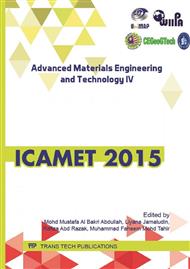p.136
p.142
p.146
p.151
p.159
p.164
p.169
p.174
p.179
Rigid Polyurethane Foam with Ionic Liquid Modified Multi Walled Carbon Nanotubes Composites
Abstract:
The rigid polyurethane (PU) were produced using ionic liquid (IL) modified multi walled carbon nanotubes (MWCNTs) by reaction of palm oil based polyol (POP) with methylene diphenyl diisocyanate (MDI). The 1-butyl-3-methylimidazolium tetrafluoborate (BMIMBF4) used as IL to disperse MWCNTs in PU foam by grinding in ratio 1:3 by weight of MWCNTs to IL till black paste were obtained. The effects of different percentage of modified MWCNTs (0.0 - 3.0 %) on Polyurethane / Multi Walled Carbon Nanotubes / Ionic Liquid (PMI) foam composites were evaluated in density, morphology and compressive strength. The density were increased higher 0.0538 kg / m3 at 3.0 % PMI. The average cell size value higher without addition modified MWCNTs and scanning electron microscopy (SEM) showed inhomogenously structure with addition of modified MWCNTs. Compressive strength with 0.5 % PMI showed the highest value 1.671 MPa compared to other PMI.
Info:
Periodical:
Pages:
159-163
Citation:
Online since:
May 2016
Keywords:
Price:
Сopyright:
© 2016 Trans Tech Publications Ltd. All Rights Reserved
Share:
Citation:


